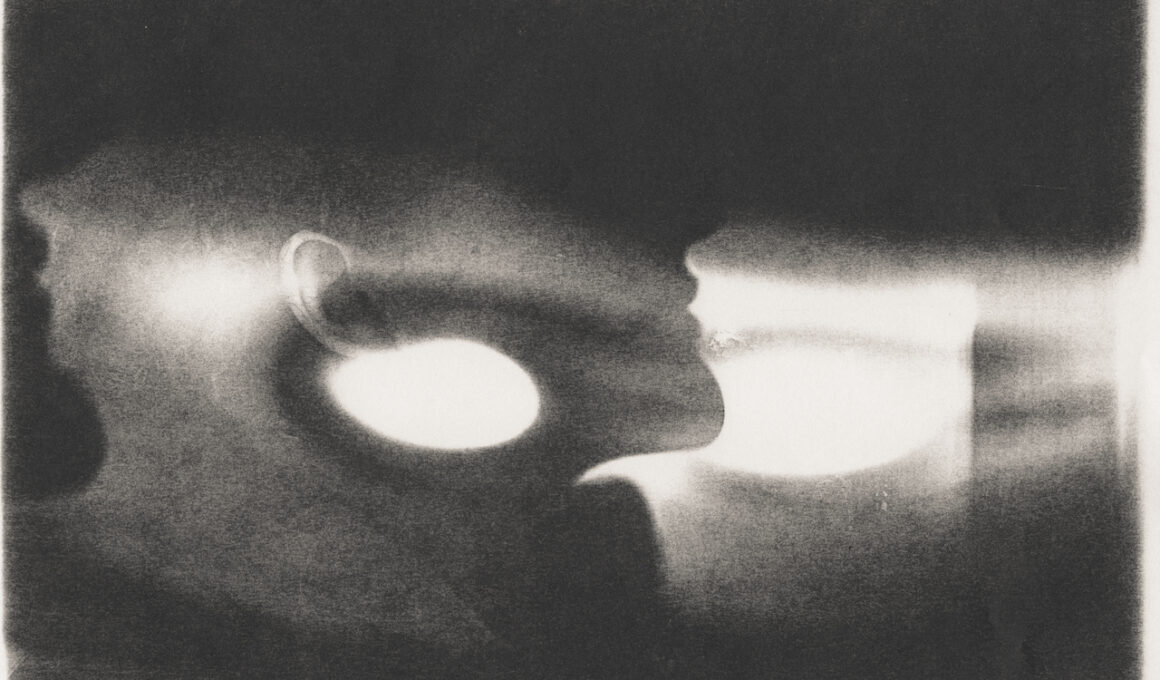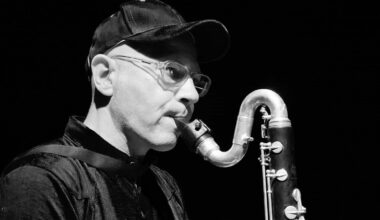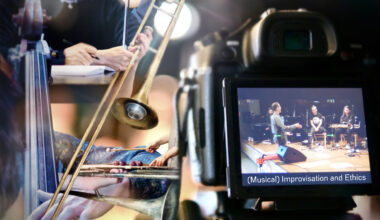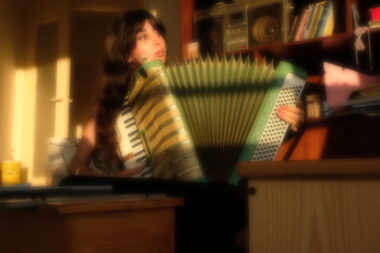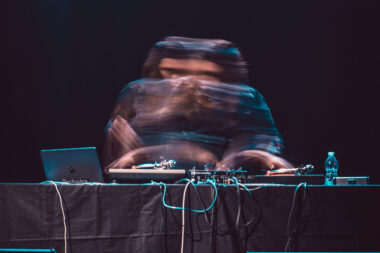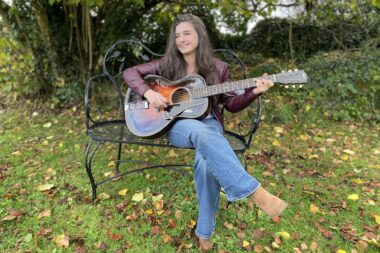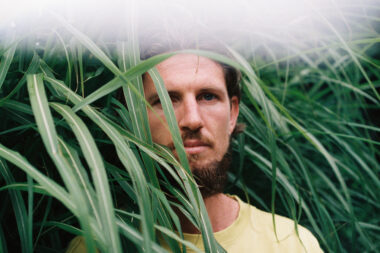Dylan Peirce is a multidisciplinary artist who works in the field of sound, experimental photography, sculpture, video and installation. In 2022, he is releasing his first album “Pindrops” on the new Berlin-based label D/B . He teaches sound and installation at the UdK Berlin since 2018, and has been one half of the artist duo Astali/Peirce since 2000. His work has been exhibited internationally – selected exhibitions include: Rennes-Biennial for Contemporary Art (FR), KW Berlin (DE), DeVleeshal Middelburg (NL), Art Museum Guangzhou (CH), Petra Rinck Galerie (DE), Anselmi (IT).
Kristoffer Cornils spoke with Dylan about his art, music and the making of his first album Pindrops, which is the first releases on Digital in Berlin. Following a sculptural approach, Peirce lets small sound events mutate into densely layered soundscapes and elaborate, rhythmic compositions. This album not only gradually shifts our perception, but also radically calls it into question.
QUESTIONS
1. What role did music play in your artistic practice before?
My latest video installation Horizon (2021 – 2 channel video, 48min, room installation, in collaboration with Tolia Astali) is very much driven by sound – i designed the sound to provide the mass needed to support the visual of a large scanner machinery, and articulated it as an emphatic machine of sorts – the sound tracks is basically a 48min composition, that consists of the permutation of three 6 min sequences.
Over the years, I have used sound in a variety of works in the field of physical theater, visual art and sound design. This involved amongst others building and performing with instruments, objects, actors and spaces.
Here is the description of a few works:
a large double necked okarina that can be played by multiple performers at the same time – one performance involved a piece for 2 performers driving one low bass note for as long as the performers could alternate in sync without losing continuity (6 hours)
a piece of landscape art that involved building an aeolian harp tensed by the weight of a human performer; another version where the tension of the string is driven by 2 performers leaning against each other.
a free-standing house where 2 adjacent rooms were used to generate standing wave feedback tones that were about 1 semitone apart … When people entered the room the resonant frequency of the room was affected and with it the standings waves, thus modifying the beating occuring between the 2 spaces.
a blow fan blowing into the mouth of a large glass vessel filled with water creating a closed pipe tone that shifts gradually in pitch till the entire water evaporates from the vessel over the period of a few weeks.
a pile of about 200 udu-inspired clay vessels of varying sizes with an array of microphones placed inside in order to amplify the filtered sound/resonant frequencies from inside the vessel. The sound from inside the vessels was played back into the space on a set of amplifiers following a slow sine like variation in amplitude that eventually let to regular feedback peaks, crests and drones.
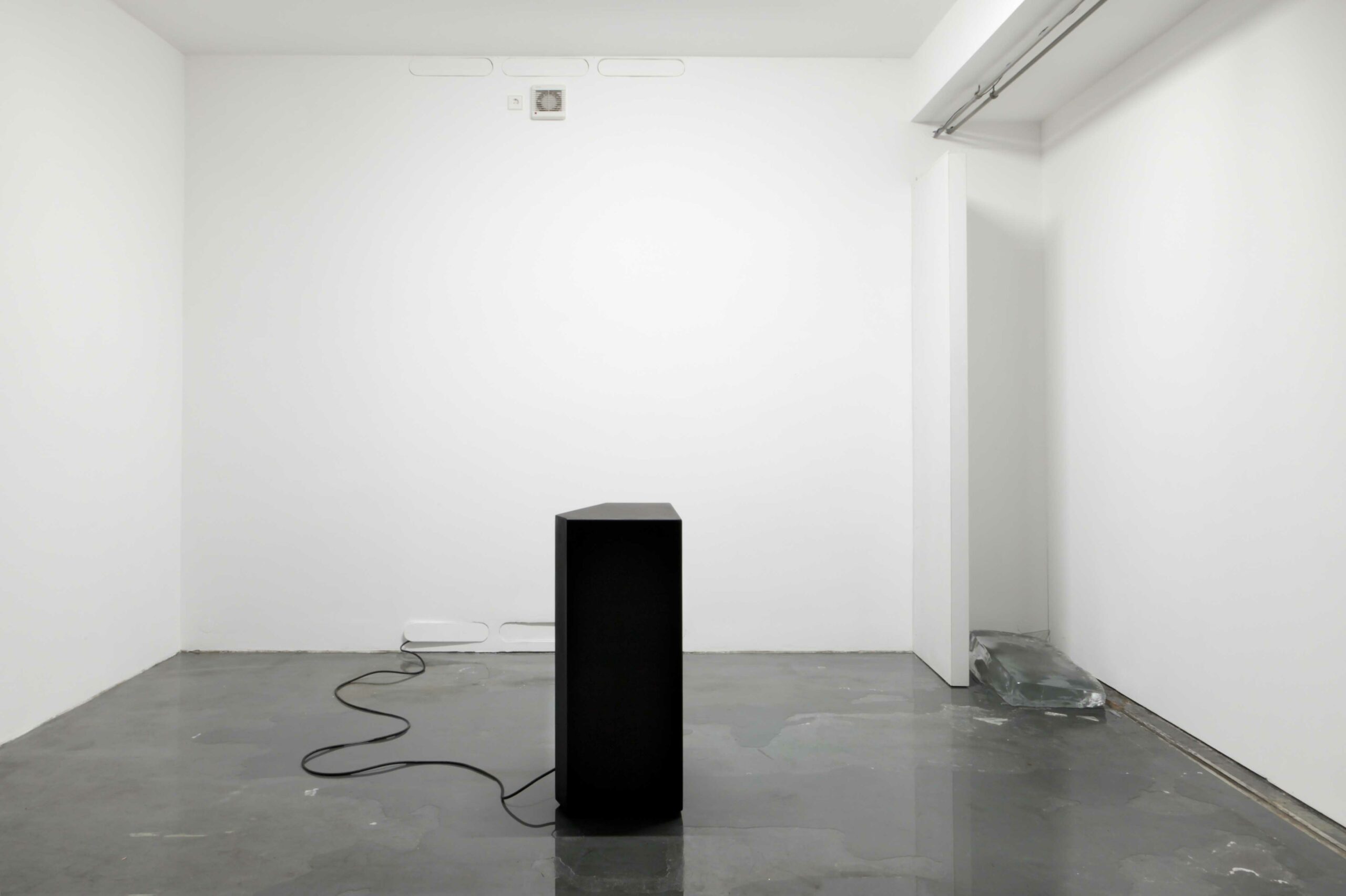
a room installation featuring a large sound system type speaker, the sound of synthetically produced and artificial sounding water trickles, a large block of ice, and an image of artificially created waves in a fluid mechanics study pool
2. Would you say that what you do in the visual realm and in sound is somehow related?
The sound work on Pindrops is perhaps the most visual work I have made to date. Generally, I would say that everything I do stems from a sculptural perspective and approach.
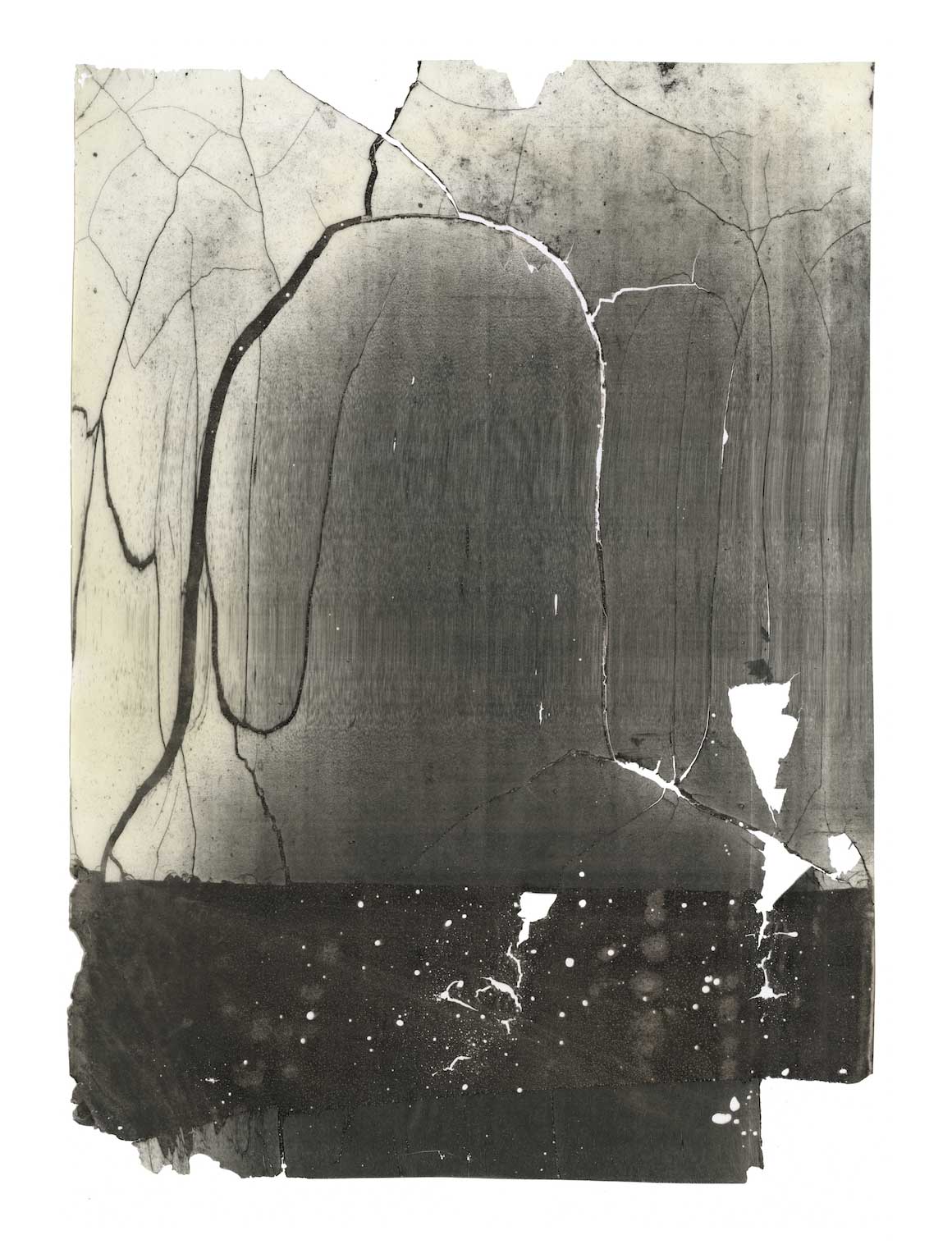
This connection is only quite recent though – prior, with the exception of the sound / instrument / installation pieces described above (that are more involved with sound per say and forming connections between people, situations, objects, spaces, etc… rather than with music as „organized“ sound), „music“ making was for me a seperate activity that was situated in relatively “normed’ spaces: funk / hip hop / electronica etc… it took me a long time to break that frame and start approaching music from a more sound based perspective: understanding rhythms as kinetic relationships and mechanisms, thinking of polyrhythms as allegorical for natural cycles, considering the continuity between rhythm and pitch and visa versa … for this, i owe a lot to the writings of Steve Coleman (see „The Lunar Cycle As A Point Of Departure For Musical Ideas” – Arcana III edited by John Zorn)
3. How did the album come about—were there specific themes that informed it, did you follow a concept
The concept seldom comes prior to the work, but rather profiles itself in the material gathered – it is my job to spot it and help it find its own voice and contour.
In Pindrops, each tracks offers a different point of view and focus upon a shifting form: from super close-up singular sound objects to large shifting architectural masses riding a bed of gridlike pins to an immersion into the vibrational core of a pulsating sonic body over to a pastoral vista populated by buzzing insects and distant bleating strings – Side B descends slowly into a resolutely more tectonic, geological plane. To that extent, the composition is akin to a „camera fahrt“.
I’d add that any reckoning with land and soundscapes is necessarily a reckoning with ecology, and the state of the world today, and tomorrow.
4. I’m especially curious about the track titles, since they seem to refer to what is being used/happening in the tracks. How do they relate to the music exactly?
Perhaps i can mention the cover, which i designed, and the way it relates to the title: PINDROPS:
„you could hear a pin drop“ is a way of saying in English that you could hear the quietest of sounds. In order to get my sounds, I manipulate objects and often close-mic these manipulations in order to extract fine details and nuances… I find that the quietest sounds and the lightest of materials are often the most eloquent – they seem to evolve in a separate universe. By amplifying and transposing a sound, one performs a semantic operation: something that was small and quiet becomes heavy and large – it’s akin to turning a pin drop into a monument.
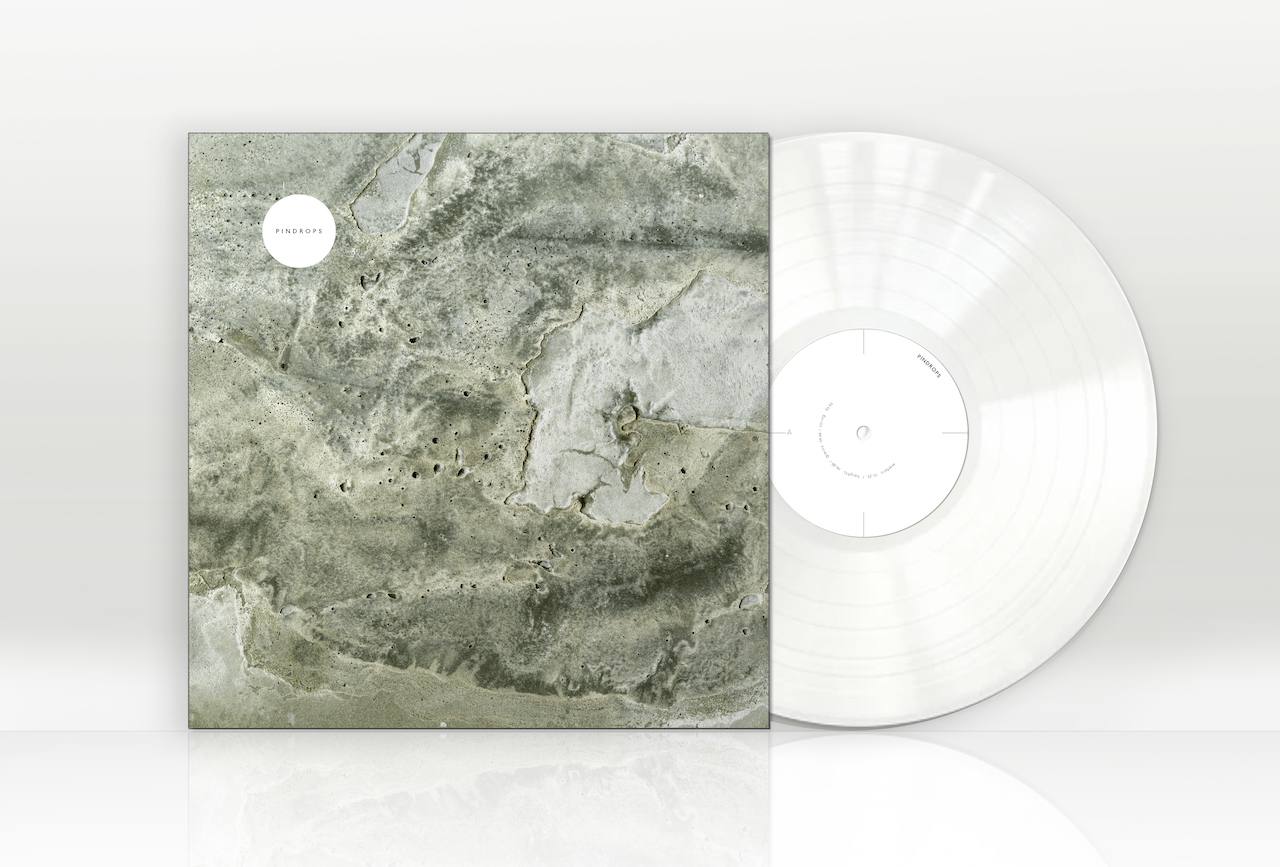
The cover of the album plays with a similar process :it is a hires scan of a concrete spill that leaked out of a cast I was making in my studio. When it came to finding an image for the album, I wanted something that related to landscape and materiality and I thought about these images – they raise this question: what am I looking at? Is it the image of a strange landform, a deserted post-aquatic landscape, or is this an image of a small microscopic surface? Moreover, I liked the pun with concrete and „musique concrete“. The Pindrop title worked well too, since pins are also what one uses for marking points on a map.
The title of the tracks describe the journey, but also work like a list of elements – like component parts, or a list of ingredients. They are also placed on the “map” like locations on the back side of the album cover.
5. How would you describe your compositional/working process?
I don’t have a fixed routine but I can describe one pattern: I start from a sound, usually a recording, like for example the hissing and creaking bellows of an old accordian, or a piece of polystyrene rolling down a piece of cardboard or the sound of ants moving across the surface of a contact mic. Next I will spend ages just listening, basically, to that sound – what is in the sound- where is it going – what does it evoke – does it call for anything – does it have a phrasing – a rhythm – a tone – a mood? From there, it’s an additive process – one sound calls for another. Some of the more complex tracks can just “happen”, whilst others can literally take months to assemble, disassemble and balance.
6. How was the album recorded—what tools did you use, what approach did you follow?
here is a list of the tools/techniques i use:
Recording – i basically regularly engage in material investigations where i cook up sonic combinations – and i experiment with different micking techniques – then i spend a lot of time cutting, processing (denoise, gatings, eqing, taming peaks, etc…), tagging, archiving, building sample maps with very small snippets, making loops, etc…- sometimes i process the stuff quite heavily to bring out the grain, etc…
Synthesis – the standard lot – all soft synths: FM synthesis for metal, wood, bells, morphing pads, textures and harsh mayhem – Granular synthesis for stretching, pads, hits, beats and general sound design – Additive synthesis for resonance and partials – Samplers for complex looping patches and risers/downers – Convolution Reverb with my own impulses for room
Noise – i use the stereo electromagnetic sensors i built for static and „nice“ noise, and an array of contact mics and feedback
Re-amping – i have a couple of old amps and devises that i use for reamping, cassette players, the four track i got age 14 that kinda works, ect…
Reverbs -a couple of large plate reverbs i built and a couple of spring reverbs (one has a 2 meter spring) that i use in combination with digital reverbs
Sequencing – all in the box
Controllers -I don’t really use any controllers (though i have some as decoration;-) – generally my process is more akin to painting – the controller seem too rugged a tool – i like the fine brush :-)
7. You seem to be working with field recordings or at least very concrete sounds, for example. Do you have a specific approach to collecting/working with these sounds?
Recording is at times just a means for me to listen better, or to take time to „become ear“ so to speak – from that perspective, recording tools are a good way to discipline oneself to take time off and reify one’s focus. It’s also a great way to become aware of one’s surroundings. Actually listening to or using the actual recording can be secondary, or come later.
Manipulations: i record actual building processes that involve handling materials of different sorts like clay, wood, plaster, tape, polyesters. The recordings are a trace of the work produced, and operate almost as a ghost of the work.
Instruments: I record broken instruments and seek out instruments on my travels – i experiment with different ways of activating them and recording them.
Impulses and reflections: one can see architecture as a large instrument, corridors as long closed pipe flutes for example. Casting white noise bursts is a great way to illuminate the sonic properties of a space. It is interesting that one can capture these sonic imprints too. Doing this in the city produces the streets as large canyons – it transforms the city into an acoustic labyrinth, rife with a host of complex acoustic reflexions.
Usually there is a time of collecting, a time of processing and a time of working with the recordings as primary material. I have a relatively large archive of sound now. Come the next project however, I might follow Herbert’s advice: scrap it all, and start again – there’s always something to listen out for, out there.
